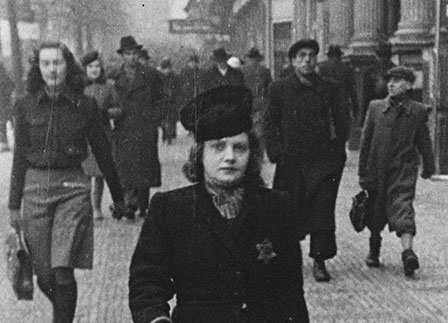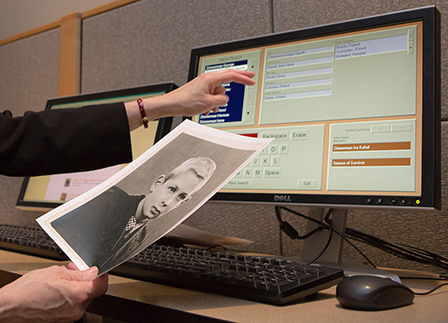Overview
- Brief Narrative
- Spanish style stele or tower tombstone with an engraved Ladino inscription recovered from the Jewish cemetery located on Sevastopol Street in Bucharest, Romania. It has the symbol for a Kohen, a priest, a hand with the fingers separated into two sets of two. The modern Jewish community has undertaken work to preserve what remains of the site. Other remaining gravestones were moved to the Sephardic cemetery in Bucharest. The Sevastopol Street Jewish cemetery was a historic cemetery where burials ceased in 1864. In September 1940, the right-wing, Nazi-allied government of General Antonescu and the Iron Guard seized power. Violence against Jews was common and there were two major pogroms, in Bucharest and Iasi. In 1942, the regime ordered the cemetery demolished. Work began on June 25 and continued through 1944. Jewish forced laborers were made to remove the stones and break them into pieces for paving material.
- Date
-
creation:
approximately 1715-before 1864
- Geography
-
use:
Sevastopol Street Jewish cemetery;
Bucharest (Romania)
recovery: Sevastopol Street Jewish cemetery; Bucharest (Romania)
- Credit Line
- United States Holocaust Memorial Museum Collection, Gift of the Federation of Romanian Jewish Communities
Physical Details
- Language
- Ladino
- Classification
-
Jewish Art and Symbolism
- Category
-
Jewish ceremonial objects
- Object Type
-
Jewish sepulchral monuments (lcsh)
- Physical Description
- These two carved stones form is a single grave marker known as a stele, that was placed lengthwise upon the ground.
a. Right side of an angled, rectangular cube shaped, gray sandstone stele or grave marker with a flat base and sides, a slanted top face, and a flat top. There is a line of Ladino text carved on the face and top and a recessed panel with a carved floral and leaf garland across the middle. The stone is worn and chipped on all sides. It is broken with a rough but nearly straight edge on the left side.
b. Left side of an angled, rectangular cube shaped, gray sandstone stele or grave marker with a flat base and sides, a slanted top face, and a flat top. There is a line of Ladino text carved on the face, one side, and top and a recessed panel with a carved floral and leaf garland across the middle. On the left side near the top is a carved hand with the fingers split into 2 sets of 2, as for a blessing, the symbol for Kohen or priest. The stone is worn and chipped on all sides. It is broken with a rough but nearly straight edge on the right side. - Dimensions
- a: Height: 15.000 inches (38.1 cm) | Width: 22.375 inches (56.833 cm) | Depth: 8.875 inches (22.543 cm)
b: Height: 13.375 inches (33.973 cm) | Width: 29.500 inches (74.93 cm) | Depth: 7.750 inches (19.685 cm) - Materials
- a : sandstone
b : sandstone - Inscription
- a-b. front, carved : בא שמשו ביום טו לחדש מנחם שנת התרי"ז [his sun set on the 15th day of the month of menahem of the year [5]617 (1857)
a. top, carved : תהי]ה מנוחתו כבוד [may he rest with respect]
b. top, carved : הלך לבית [חיים [he went to the house of life (was buried);short for פה טמון - here is buried]
b. side, carved : נתן ב אלישע ה[כוהן] יהו [nathan son of elisha hacohen]
Rights & Restrictions
- Conditions on Access
- No restrictions on access
- Conditions on Use
- No restrictions on use
Keywords & Subjects
- Topical Term
- Holocaust, Jewish (1939-1945)--Romania--Bucharest. Jewish cemeteries--Desecration--Romania--Bucharest--History--20th century. Jewish cemeteries--Destruction and pillage--Romania--Bucharest--History--20th century. Offenses against religion--Romania--Bucharest--History--20th century. World War, 1939-1945--Jewish cemeteries--Desecration--Romania--Bucharest. World War, 1939-1945--Jewish cemeteries--Destruction and pillage--Cemeteries--Romania--Bucharest.
Administrative Notes
- Legal Status
- Permanent Collection
- Provenance
- The tombstone was donated to the United States Holocaust Memorial Museum in 2005 by the Federation of Romanian Jewish Communities.
- Funding Note
- The cataloging of this artifact has been supported by a grant from the Conference on Jewish Material Claims Against Germany.
- Record last modified:
- 2022-07-28 18:30:15
- This page:
- http://collections.ushmm.org/search/catalog/irn533151
Download & Licensing
In-Person Research
- By Appointment
- Request 21 Days in Advance of Visit
- Plan a Research Visit
- Request to See This Object
Contact Us
Also in Federation of Romanian Jewish Communities collection
The collection consists of three broken tombstones recovered from a desecrated Jewish cemetery on Sevastopol Street in Bucharest, Romania, that was destroyed during World War II.
Date: before 1864
Broken pink gravestone with a Ladino inscription from a desecrated Jewish cemetery recovered postwar
Object
Desecrated, partial pink tombstone with an engraved Ladino inscription recovered from the Jewish cemetery located on Sevastopol Street in Bucharest, Romania. The modern Jewish community has undertaken work to preserve what remains of the site. Other remaining gravestones were moved to the Sephardic cemetery in Bucharest. The Sevastopol Street Jewish cemetery was a historic cemetery where burials ceased in 1864. In September 1940, the right-wing, Nazi-allied government of General Antonescu and the Iron Guard seized power. Violence against Jews was common and there were two monstrous pogroms, in Bucharest and Iasi. In 1942, the regime ordered the cemetery demolished. Work began on June 25 and continued through 1944. Jewish forced laborers were made to remove the stones and break them into pieces for paving material.
Broken tombstone with a willow tree from a desecrated Jewish cemetery recovered postwar
Object
Partial gravestone with a carved willow tree and Ladino inscription recovered from the Jewish cemetery located on Sevastopol Street in Bucharest, Romania. The modern Jewish community has undertaken work to preserve what remains of the site. Other remaining gravestones were moved to the Sephardic cemetery in Bucharest. The Sevastopol Street Jewish cemetery was a historic cemetery where burials ceased in 1864. In September 1940, the right-wing, Nazi-allied government of General Antonescu and the Iron Guard seized power. Violence against Jews was common and there were two monstrous pogroms, in Bucharest and Iasi. In 1942, the regime ordered the cemetery demolished. Work began on June 25 and continued through 1944. Jewish forced laborers were made to remove the stones and break them into pieces for paving material.



